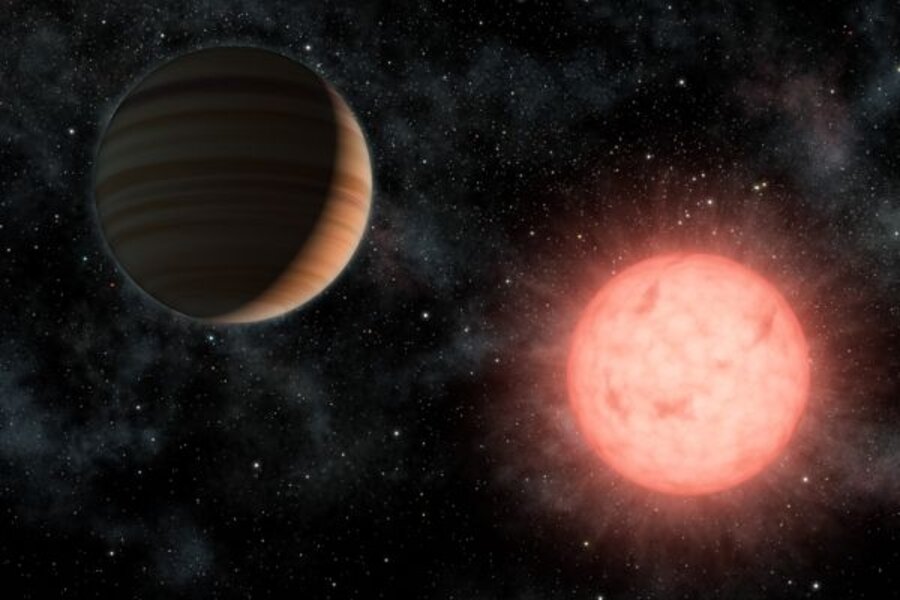A bizarre new solar system, and a new tool for finding it
Loading...
Add one more arrow to the quiver available to planet hunters hoping to bag planets around other stars.
For the first time, a team of astronomers has successfully used a technique called astrometry to find a "candidate" planet orbiting another star -- a so-called exoplanet. And what a find it is.
The suspected planet, dubbed VB 10b, is seven times more massive than Jupiter. It's orbiting its star at roughly the same average distance at which Mercury orbits the sun. But instead of roasting like similar giant planets at similar distances from their suns, this giant is still experiencing the big chill.
The reason: It's star is not exactly the brightest bulb on the shelf. It's got only one-twelfth the sun's mass. In fact, for years it's held the record as the smallest star yet discovered. It's very low mass throws it into the "ultracool" category.
All together now: So how dim is it? It's so dim it essentially falls off the bottom of the scale astronomers use to track the relationship between a star's mass and its brightness.
If the results hold up to additional scrutiny, it would be the smallest star to host a planet. And while the star, VB 10, is significantly more massive than the planet, they both have roughly the same diameter.
The pair is located about 20 light-years from Earth in the constellation Aquila.
Scientists found the planet using a technique astronomers have been toying with for planet-hunting for at least 26 years -- astrometry. It's a time-honored technique (think 190 B.C.) for measuring the position of stars and other cosmic objects, and tracking their movements over time against apparently "fixed" stars at greater distances.
In 1983, three astronomers with the US Naval Observatory published a paper in the Astronomical Journal reporting that two low-mass stars, VB 8 and VB 10, appeared to have low mass companions. They used astrometry to make their measurements and estimated that the companions' masses would be a few thousandths the mass of the sun.
Unfortunately, the results couldn't be confirmed, so the report wasn't given much credence.
Then along comes Steven Pravado and Stuart Shaklan, two researchers at NASA's Jet Propulsion Laboratory in Pasadena, Calif. They used the historic 200-inch telescope on Mt. Palomar, north of San Diego. They made their observations over nine years, beginning in 1999.
As they put it, VB 10 "is an astrometrist's dream in a nightmarish setting." It's close, has low mass, and there are lots of stars in its background whose positions are well-measured. But, the star's low mass also means it's very dim, and its close proximity means it appears to move a lot against the background stars, covering and uncovering them, making it hard to use some of them as reference points. While all this is going on, the movement the duo is trying to detect -- many times -- is the rough equivalent of the seeing something shift by the width of a human hair from about 2 miles away.
But spot it they did, apparently, and the planet has a mass of (drum roll here) about 0.006 solar masses -- in the ballpark the Naval Observatory researchers estimated. You can find a formal report on their find in pdf form here. A plain-English version appears here.
For all that, Dr. Pravado says in an email exchange, it takes about the same amount of time to get a solid observation as it takes astronomers who use other, more common techniques. These include the so-called radial velocity approach -- essentially measuring the wobble an orbiting planet imparts to its host star, a wobble seen in the star's spectrum.
You want to detect as many of the planet's orbits as possible. In VB 10b's case, it orbits its star once ever 271.6 days -- basically three-fourths of a year.
The star's dimness puts its "habitable zone" (not too hot, not too cold, but just right for liquid water to remain stable on an object's surface) at around 9.3 million miles out from the star. The close proximity of the giant planet suggests that this zone overlaps a region between the giant and the star where another planet, say a rocky, Earth-like orb, would be held in a stable orbit around the star.
No one is suggesting such a planet is there. But it does represent a kind of sweet spot for any planet that might find itself there. And since seven out of every 10 stars in the galaxy are thought to be these low-mass dimsters, these stars are "fertile ground for future Earth searches," according to Dr. Shaklan.
And these are just the kind of planets the Kepler mission is hunting for!





